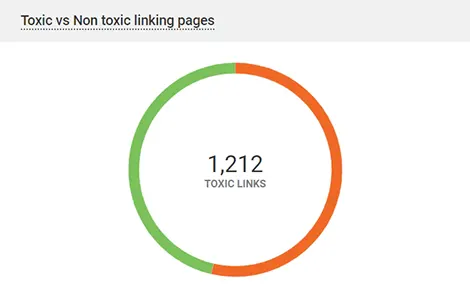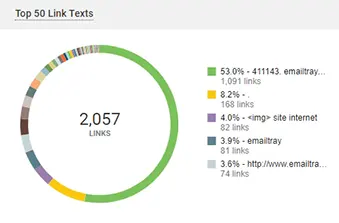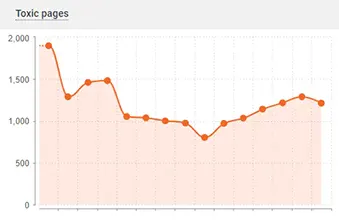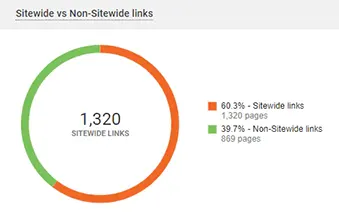Toxic Backlink Checker Tool
Protect and recover your rankings - start link detox with WebCEO Toxic Backlink Checker

Why WebCEO Toxic Link Checker
- Find and audit yout backlinks fast and with no extra effort
- Discover potentially spam backlinks on the fly
- Get an automatically generated disavow file
- Send toxic links to the Google Disavow tool
- Be informed about all high-quality juicy links to your site
- Run a complete backlink audit using Majestic & MOZ metrics
- Get email alerts about any changes in your backlink profile

The most trustworthy link database
WebCEO offers the most powerful and reliable spam link checker in the SEO niche which is integrated with Majestic - a backlink data provider with the largest link index database in the industry. It currently features over 2,371,111,956,878 URLs and is updated daily.
You're not required to have a Majestic subscription. WebCEO has already paid for Majestic data so you will not need to.
Check your site for toxic links
Get the Most Out of the WebCEO Toxic Backlink Checker
Get the list of all backlinks to your site found by Majestic on a page and domain level.
Check if there are relevant good links with ‘rel=nofollow’ that pass no link juice. Search engines will not give such links credit so you should try to influence webmasters to make them ‘rel=follow’.
Evaluate each backlink. Domain Trust Flow and other link authority metrics will help you determine whether a given link is good for your backlink profile.
To keep your backlink profile clean and safe, WebCEO has created a specific toxicity formula that helps to identify toxic backlinks.
The default values are set for the best performance. However, you can adjust them manually according to your own requirements.
It has never been so easy and fast to create, import and export ‘disavow.txt’ before. Now it’s simple with the new integrated functionality.
Set WebCEO to automatically scan the websites you want to monitor.
Select the SEO tasks you want to receive an email alert about in case any changes happen.
Dive Deep into Your Backlink Profile

Perform Link Detox - inspect page and domain-level insightful SEO metrics to analyze your backlinks authority and ‘power’ at a glance:
- URLs of linking pages and linking domains
- Link Text/Type
- URL/Domain Trust Flow
- URL/Domain Citation Flow
- Organic Traffic
- Domain Age
Review and analyze your backlinks in batch mode and do link removals with the help of Google's disavow tool.
Download the Sample Report
How to Remove Toxic Backlinks
- Get in touch with the webmasters of these sites and file a request. But you can’t be sure the answer will come quickly; sometimes they won’t answer at all.
- Use the Google Disavow Tool. This is the way to report those toxic links to Google so that Google ignores them when assessing your site. You should still make every effort to remove unnatural links pointing to your site. Simply disavowing them isn't enough.
To get better ranked on Google or to recover from a Google penalty and earn your rankings back, take care of your backlink profile purity. Google Penguin exists as part of the core search engine algorithm, and targets spam links and manipulative link building methods. The Penguin algorithm also considers the entire link profile, and the volume of relevant high-quality links versus the number of spam links.
Don’t let toxic links drag your rankings down!
The aim of the Toxic Pages report is to clean up your backlink profile. You can easily monitor this from the Toxic vs non-toxic linking pages widget in My Backlinks.




How WebCEO Toxic Backlink Checker Works
URL/Domain to Analyze

Backlink Quality Checker finds backlinks
Web CEO gets backlink data from Majestic
(a powerful link database)
MAGIC ALGORITHM
The detailed analysis of each linking domain and each backlink (Total Links, Lost Links, Juicy Links, Nofollow Links, Link Text/Type etc.)
Links are marked toxic by a number of factors. The default values are set for the best performance, however, you can adjust them manually according to your own requirements.
REVIEW YOUR BACKLINKS
Add to tracked links
(PARTNER LINKS WATCH)
Be sure that your most important backlinks are intact. We will check if they are crawlable by search engines and monitor what link text is used.
Add to Disavow list
Report non-desirable links to Google. Google will ignore those links when analyzing your overall backlink profile. Thus, toxic links will not harm your Google rankings.
Save time with the WebCEO Toxic Link Checker & Protect Your Site from Google Penguin
WebCEO offers you a 100% Penguin-proof and effective tool for the best link building strategy
Toxic Backlinks FAQ
Toxic, or unnatural links are those incoming links which are not relevant, low-quality and done incorrectly. Toxic backlinks come to your website from websites which are not indexed by Google, spam websites, link farms, virus sites and malware websites created only for link building. Link building with such sites is unsafe and usually ends up with a Google penalty.
The easiest way to detect toxic backlinks is to look through your report at WebCEO Backlink Profile > My Backlinks (you can schedule scanning and reporting weekly, monthly or quarterly). But there are a few ways to detect toxic backlinks:
- Obviously you will notice a sudden drop of your traffic level. Toxic backlinks are harmful for your rankings, so you will see the organic traffic going down.
- Also, you may receive a warning e-mail from Google. The search engine stands against manipulating SERPs, so they will detect black-hat SEO activity and send a warning notification.
- After checking a regular report on your backlinks, you will know better what’s on with your backlink profile. WebCEO’s ‘Linking Domains’ and ‘Backlinks’ reports show toxic links in red – so it’s hard not to notice them!
The disavow tool is a part of the Google Search Console that allows websites to discount the value of some of their inbound links. This honest self reporting helps Google to know you don’t deserve any penalties.
Usually it takes around 2 days (48h) for all Google bots to take notice that there is a new Disavow file for your domain. Then, it will take from 1 to 8 weeks till the Google bots rescan the web – they have their own schedule. Keep in mind that a bot won’t scan the web immediately after receiving your disavow file.
There are a few reasons why you do.
- You created them. BTW, paying for links or content spamming are not the best ways to build an authoritative backlink profile.
- Your SEO services provider buys you cheap links from questionable websites.
- You are a victim of a negative SEO attack.
The good news is that you can still disavow those links and make your backlink profile powerful and back to working for you, not against you.
Spam means different black hat ways to manipulate search engine indexes. There are a few types of spam in SEO:
- Content spam: keyword stuffing, hidden or invisible text, meta-tag stuffing and other manipulations, doorway pages, scraper sites, article spinning, machine translation.
- Link spam: link farms, private blog networks, hidden links, spam blogs and guest blog spam, comment spam, wiki spam, cookie stuffing and much more.
- Other types: mirror websites, URL redirection, cloaking.
Keep in mind that these spam SEO techniques will not give you long-lasting results.
- Turn on Google Search Console email alerts. Google will send you a notification whether your website is being attacked by malware, your pages are not indexed, there are problems connecting to your server or even when you get a Google penalty.
- Regularly scan your backlink profile. You can easily perform backlink analysis with WebCEO. This is the most important step to prevent spammers from succeeding.
- Protect your valuable backlinks. Spammers may try to contact the owner of the link and ask them to remove the link, as if they were you. The best thing you can do is to contact website owners only with an email from your domain, so you can easily prove your direct relation to the website. Keep an eye on your best backlinks with the Partner Links Watch tool.
- Check if there is duplicate content on the web that originally came from your website – this is quite a popular technique negative SEO spammers use. If your content is being duplicated, your website probably will be penalized and lose positions on SERPs.
- Check your website speed because spammers may be sending thousands of requests per second to your server (Site Health > Technical Audit & SEO Analysis tools). If you don’t detect this in time, your server will go down.
- Don’t be your own enemy and don’t make enemies online. Using those unnatural link building techniques won’t make your website popular nor rank high.
